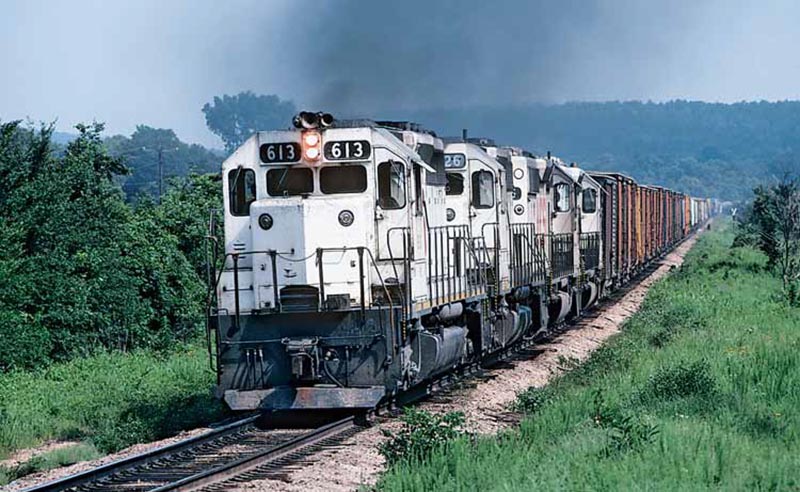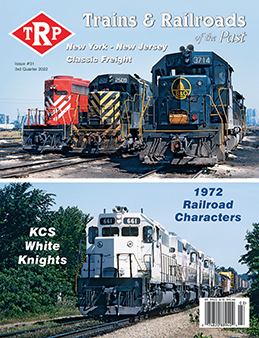 by Carl Graves/photos as noted
by Carl Graves/photos as noted
A September 2021 news story I read said that the Kansas City Southern and the Canadian Pacific have agreed to merge, with the new company being called Canadian Pacific Kansas City! This revelation came almost exactly 50 years after I began photo-graphing the KCS. That corporate shakeup has spurred me to write a story about my time in the 70s and 80s with this soon-to-be fallen flag. In terms of years, my photographic interest in this railroad has surpassed that for any other train company for two reasons. First, I was attracted to its paint schemes, which went from red to white (with red letters) to gray (with red and yellow highlights) to “Retro Belle” (red, yellow, and black). Second, except for Union Pacific, the KCS outlasted all other railroads I followed with my camera from 1971 to 2015. My first-ever car chase of a train to get multiple shots of it was of a KCS freight in 1971 between Page, Okla., and Rich Mountain, Ark. My last such endeavor was following a southbound Retro Belle freight in 2015 from a south Kansas City inter-modal yard to Pittsburg, Kan.
On the one hand, the Kansas City Southern was not my favorite railroad to shoot. Train frequency was sparse compared to many other lines, especially the Santa Fe and the Union Pacific. In addition, the main line’s north-south orientation meant that northbounds were often backlit for much of the year. Foreign power sometimes powered KCS coal trains, which hindered my effort to photograph the company’s locomotives. On the other hand, those nifty white KCS diesels and the railroad’s path through the scenic Ouachita National Forest along the Oklahoma-Arkansas border region kept me coming back. My comments and photos will focus on the two areas that I visited: the 30 miles of main line between Heavener, Okla., and Rich Mountain, Ark., and the 60-mile stretch immediately south of Kansas City.
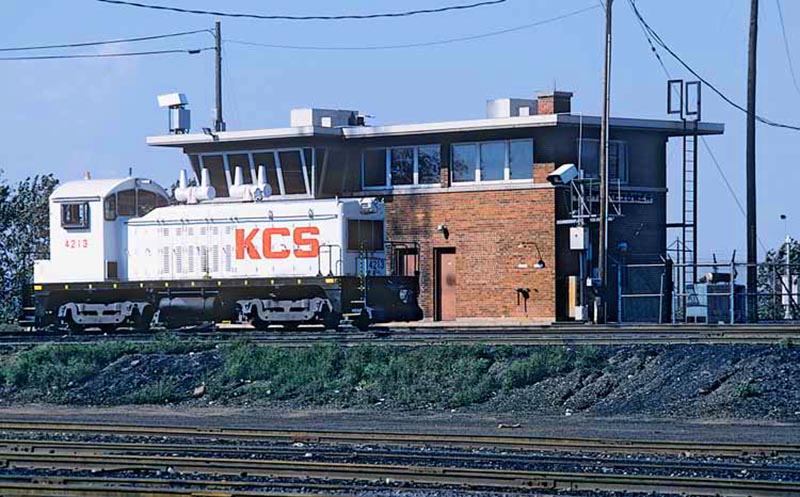
ABOVE: Wearing a fresh coat of bright white paint in November 1987, elderly NW2 4213 looks like a spring chicken as it idles at the edge of Knoche Yard’s east side next to West Wye Tower, which is located near Airline Junction. —Jim Rhynerson photo, collection of Bob Franke
First Contact
Half a century ago, my railfan friend Paul Walters and I decided we would drive east from our central Oklahoma homes to check out this unknown-to-us railroad. It was the summer of 1971, and we were college students on summer break. We got curious about the KCS abbreviation we saw on a winding line through the northeast corner of the Sooner State map in my Rand McNally Handy Railroad Atlas. Adding to our curiosity was his highway map, which showed the railroad going through a spot called Rich Mountain. It was time for us to plan a road trip!
Our exploratory visit to this mysterious line was hampered by our lack of funds as well as our poor photographic skill and mediocre camera equipment. Paul persuaded his father to loan us his big Pontiac Bonneville sedan, in which we left town after he returned from work. We drove 230 miles into eastern Oklahoma, which looked vastly different than the plains and cross timbers region around our homes in Edmond. As we left the main road from Oklahoma City to Ft. Smith, we passed through the rugged Sans Bois Mountains, the quiet KCS yard at Heavener, and then the heavily-wooded Ouachita National Forest. The terrain reminded me of Appalachia. Seeing no trains, we decided to spend the night by the main line and siding at Page, which was near the Arkansas border. We lacked money for even a cheap motel and relied on snacks from home rather than buying restaurant food.
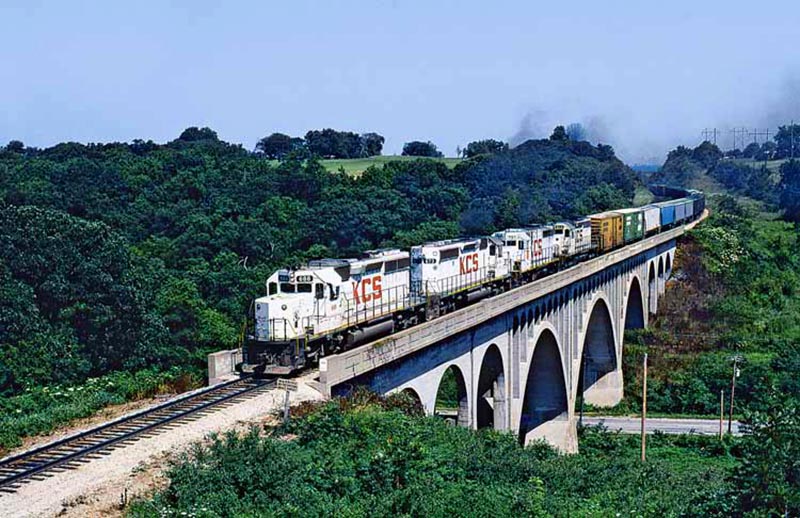
ABOVE: Here is a great overview of the bridge over the Blue Parkway at Swope Park seen earlier. Kansas City Southern SD40-2 688, 673, GP40 791 and SD40 613 are charging across the viaduct with a southbound train on Independence Day in 1982 and the highway can clearly be seen in the central arch. Of special interest is GP40 791, which was built for the Illinois Central in 1967 and is one of 19 such units acquired from the ICG in March 1982. Kansas City’s largest park was named for Colonel Thomas H. Swope, who gave the land to city in the late 1800’s and features the Kansas City Zoo, a PGA-class golf course and many other attractions. —Kodachrome by Kevin EuDaly
It was a rough night. We decided to sweat inside the Pontiac rather than be eaten alive by the swarms of mosquitoes we encountered outside. Our fitful sleep was interrupted by a slow-moving KCS southbound, which seemed in the darkness to be two trains in one. I wondered if I were hallucinating. We didn’t realize that we were hearing the sounds of mid-train locomotives.
Our spirits perked up the next morning as sunlight slowly made its way into the valley between forested ridges, one called Black Fork Mountain, the other Rich Mountain. To the west we heard a rumble that slowly changed into a roar. Like ghosts gliding through the mist, three snow-white KCS engines pierced the fog on the valley floor. We shot the locomotives as they struggled by, pulling a long string of southbound freight cars over the rickety, weed-encrusted jointed rails. As the growls of these SD40s receded, we heard more diesel noise. To our amazement, two more white engines appeared in the midst of the train, followed by additional freight cars and a shiny silver caboose.
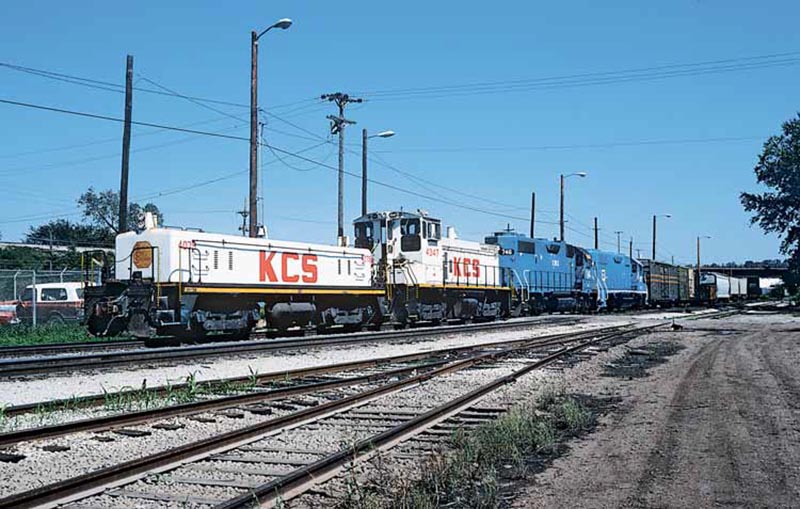
ABOVE: A KCS transfer with SW1500 4347 and slug 4079, along with a pair of blue EMD leasers are at Armourdale Yard in Kansas City, Kan., in 1989. The 4079 has had a very long history of yard service, as it was actually built as a TR2B calf unit for the Chicago & North Western in 1949 before being converted to a slug. Armourdale was a Southern Pacific yard once owned by the Rock Island. —Kodachrome by Jim Rhynerson, collection of Bob Franke
We hopped into the Pontiac and got back on US 59/270 Highway, which became our chase road. It was amazing to us that so many roaring engines struggled to keep this train going at such a slow speed, perhaps 15 mph. We did not realize that the huge train was going up a 1.1 percent grade. We got several more photos before waving goodbye as the train picked up speed after passing Rich Mountain on the Arkansas side. It was our first train chase and our first encounter with helper engines. We felt that our uncomfortable night was vindicated, so we drove back to our homes in Edmond. We had little money left and Paul’s father was anxiously awaiting our return and his Pontiac.
Triumph turned to tragedy when our slides came back from the processor. I had not realized that the winding mechanism on my Mamiya camera was failing to advance the film completely after each shot. The roll was a mess! I kept only one image — a surreal, psychedelic picture created by four overlapping exposures. Due to other mechanical problems with Paul’s Argus camera, his slides did not come out much better. In our rookie appearance at photographing trains, we had both struck out…


